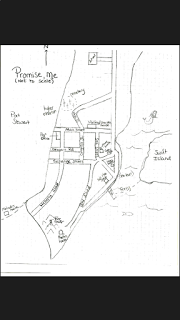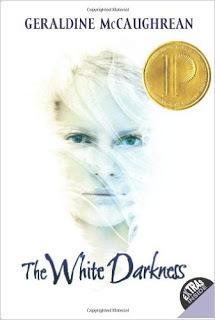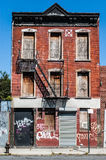Marcia Thornton Jones's Blog, page 168
July 10, 2015
Setting: It Takes More Than A Flip Of A CoinBy Marcia Tho...
By Marcia Thornton Jones
A story’s plot often dictates certain setting elements, like in my World War II historical novel WOODFORD BRAVE. I knew Cory’s story would take place in a small town during the 1940s, but while some aspects just fell into place, I found I couldn’t leave most of the setting decisions to mere chance.
 A story’s setting is more than a general sense of time and place that decorate the background; it’s also integral to character development and story theme. For example, the alley that plays an important role in WOODFORD BRAVE was intentionally chosen because it represents ‘the line’ that people draw between sides during times of conflict. In another scene, Cory sneaks into his parents’ bedroom to look at a worn silver dollar that his dad always rubbed when making tough decisions. That silver dollar was intentionally chosen as part of the setting because it’s symbolic of a decision Cory must make, as well as the idea that bravery and fear are two sides of ‘the same coin’.
A story’s setting is more than a general sense of time and place that decorate the background; it’s also integral to character development and story theme. For example, the alley that plays an important role in WOODFORD BRAVE was intentionally chosen because it represents ‘the line’ that people draw between sides during times of conflict. In another scene, Cory sneaks into his parents’ bedroom to look at a worn silver dollar that his dad always rubbed when making tough decisions. That silver dollar was intentionally chosen as part of the setting because it’s symbolic of a decision Cory must make, as well as the idea that bravery and fear are two sides of ‘the same coin’. Pondering the following questions helps me make intentional decisions about a story’s setting. Maybe they’ll help you, too.
What beliefs, traditions, and cultural influences are part of my character’s world?How have my characters’ personalities, belief systems, and behaviors been shaped by the time and place in which they live?How might the environment affect the protagonist’s emotional state? Her self perception?How does the world directly impact my protagonist’s story?How does each story character view the world? What are their unique perspectives?With what does my protagonist choose to interact? How and why? What does she avoid? How and why?What specific items have significance to the character? Why?What items in her world might be used as a motif to convey the story’s overall theme?Where does my character find refuge? Where does my character feel the most vulnerable?What about her world does my character want to change? How does that relate to her own transformation? By the way, the worn silver dollar in WOODFORD BRAVE has personal significance for me, too. My father carried the pictured silver dollar in his pocket every single day. Funny how our ‘own settings’ find their way into stories!
July 8, 2015
Jane Kelley: Setting in "THE BOOK OF DARES FOR LOST FRIENDS"

I imagined the kids literally hanging out there. I imagined them wanting to climb and being afraid to fall. I imagined them longing to escape from family life, but unable to get any farther. They are, after all, "smack dab in the middle" -- between childhood and adulthood. I imagined the cat who roamed the alley below. I imagined lots of other things that were shed from the story somewhere between drafts 2 and 11.
But the fire escape remained.
"It was a law that each building in New York City must provide an alternative exit, should disaster strike. There had never been a fire, thank goodness, and yet practically every day Lanora needed to escape."
Setting can launch the themes. (A fire escape is more air than metal, so how can it lead Lanora to safety?) Setting can enhance the dramatic tension. (Will those who climb fall?) Setting can define character. (Val swings freely from the rungs. Lanora thinks about how rust is gnawing at the metal.) Setting adds dimension. (How will they change after they climb out the window? Or climb back in?)
The fire escape is just one of many settings in the book. That's one of the joys of writing and reading---you can go anywhere.

This book is coming out on July 14.
I'm giving away 5 copies. If you are a member of GOODREADS, click on this link. GOODREADS giveaway. If you aren't a member, you should join! It's free and fun!
July 5, 2015
So Many Decisions - July Theme by Deborah Lytton
I write realistic fiction, so I am not creating fantasy worlds or dystopian societies, but I do have to choose certain things to establish setting, such as the time of year the story takes place, where the main character lives, and one of the most important things for writers of literature for children and young adults--whether the story evolves during the school year or during the summer. In my first book JANE IN BLOOM, I wanted the most pivotal scenes in the book to take place during the summer, so I began the book in the early spring and carried it through summer to fall. In my latest release, SILENCE, the book takes place in a short time period and each day is significant so the dates had to be calendared and marked by me to countdown to the crucial day in the book. I also wanted the main character Stella to have to struggle with the issue of going to school because it would have been easier for her in the summertime, so I set the story during the school year.
I spend a lot of time thinking about my character's rooms. In SILENCE, Stella has Broadway posters all over her bedroom walls. I chose this description because I wanted to share something about Stella's dreams but then I also use the posters to show how painful it is to see them when her dream is shattered. In JANE IN BLOOM, I created a bathroom that connects Jane's room with her sister Lizzie's room and this connection is central to the development of the story.
If you are writing something new, take a moment to think about what time of year it will be and why. Decide what your main character's sleeping space is like, and how you can add personal touches to help the reader connect with your character but also reveal something about him or her. And whether your book is fantasy or dystopian or realistic fiction--choose whether your character is attending school and how will this help or hurt your plot and character development. Try different versions of these things to see which fits. When you find it, you'll know!
July 4, 2015
Megan: Map Making
The Friendship Riddle follows and ever-growing group of friends as they search for riddles around their town. These riddles are clues in a scavenger hunt whose ending they don't yet know. In order for me to visualize the scavenger hunt, I drew this map of the town:
 Map of Promise, ME for the book The Friendship Riddle
Map of Promise, ME for the book The Friendship RiddleThis allowed me to figure out how and when the kids could get from clue to clue. For example, a clue in the next town over required a trolley ride.
But drawing the map also helped me to see connection between characters. Ruth, my main character, lives toward the bottom of the peninsula. Melinda, her antagonist, lives in the next town, but directly across the bay. I realized that on a clear night, they could see each other's homes.
My current work-in-progress, The Firefly Five, is futuristic science fiction, but the setting is purposefully a neighborhood that today's readers will recognize. The kids all live on a cul-de-sac. I decided to draw a map of the neighborhood so I could see where the characters' homes were in relation to one another. As soon as I drew the donut of the cul-de-sac, however, I realized a possibility I had overlooked: the kids could pass through the center of the cul-de-sac. This quiet space allowed two characters to have one of their more important conversations.
This past year I had the chance to work with young writers at the Clinton School for Writers and Artists. As they developed their stories and worlds, I encouraged them to draw maps of their settings. They, too, found that they saw new possibilities in their work. It's a technique that teachers can use with their young writers, and, of course, one I recommend that writers of all genres give a try.
July 3, 2015
And My Heart Beat, "Antarctica, Antarctica"
 My next book for the middle grade audience is WHEN THE SUN SHINES ON ANTARCTICA: And Other Poems from the Frozen Continent, with illustrations by Anna Wadham, coming Spring, 2016.
My next book for the middle grade audience is WHEN THE SUN SHINES ON ANTARCTICA: And Other Poems from the Frozen Continent, with illustrations by Anna Wadham, coming Spring, 2016.That's right. Antarctica. Could there be a more unloveable setting? And yet, and yet: I am in love with Antarctica. And I hope when readers open these pages that they will fall in love with the frozen continent, too.
 My obsession began as many of my obsessions do: with a book. THE WHITE DARKNESS by Geraldine McCaughrean. Among other honors, the book earned the Printz Award. Talk about perfect setting for a shy girl's journey through a stark, cold mystery...
My obsession began as many of my obsessions do: with a book. THE WHITE DARKNESS by Geraldine McCaughrean. Among other honors, the book earned the Printz Award. Talk about perfect setting for a shy girl's journey through a stark, cold mystery...Here's a paragraph from the opening pages:
"Come to think of it, Uncle Victor gave me most of my ice books. Every birthday and Christmas. Books about The Ice and the North Pole; about Shackleton and Scott, Laurence Gould and Vivian Fuchs, Nansen and Barrents, Franklin and Peary; about penguins and polar bears, whales and seals and boreales... About Captain Lawrence Oates, the one they called "Titus." Uncle Victor understands how the whole idea creeps up on you like pack ice -- pressing in and pressing against your head, then crushing the hull and tumbling inside... if we ever did a project in school on Antarctica, I could shine. Like Mount Erebus in midsummer, I could shine, I could shine!"
So, writers... go out there an mine those obsessions for settings... even if they seem completely unloveable -- and SHINE. xo
Bonus pic!
 a Chinstrap Penguin interior spread by the amazing Anna Wadham!
a Chinstrap Penguin interior spread by the amazing Anna Wadham!July 2, 2015
Where in the World Are We? By Ann Haywood Leal
 I have always been partial to anything that is broken-down and decrepit or unusual, because such things always spark a story for me. I can't help but imagine: Who lived there? What went on in that place over the years?
I have always been partial to anything that is broken-down and decrepit or unusual, because such things always spark a story for me. I can't help but imagine: Who lived there? What went on in that place over the years? Some people feel that in order for a place in a story to feel authentic, it has to be a very familiar place -- a place the author has experienced in great detail. But I don't necessarily agree. We can add details in a such a way that it becomes real and familiar.
And I think that setting is very subjective. We experience setting in the same way that we experience people. We all see and notice different details around us. Think about giving someone directions, for example. Some of us will deliver what I call the MapQuest version, using strictly mileage and left and right turns, while most of my writer and illustrator friends will use color, shape, and landmarks.

The details of settings add emotion to the story, because we can actually have strong emotional reactions to places, especially when we have our own history there. Certain elements may spark vivid memories, both good and not so wonderful--your childhood home, for example.
The setting is the holder of the large details, and more importantly, the tiny, sharp details of the character's world. The writer is coloring the picture for the reader. I always hope that my reader will feel as if s/he is eavesdropping -- as if s/he is a fly on the wall of the setting. Your unique setting allows the reader to crawl into your story.

My invitation to you writers out there: Notice a detail of a place as you are out driving or walking. It stands out to you in some way, but you may have no idea how or why this is. You do know that you can completely picture your character there. Write it. Do it now. See where it takes you...
July 1, 2015
June 30, 2015
TIME TO BREATHE by Tracy Holczer
I've learned that most kids feel this way. It's a familiar pain that binds us together. Especially those of us who write middle grade, I think. We fritter about, sifting through memories of those years, uncovering the golden nuggets that become touchstones in our stories. And as much as it pains me to have watched, and continue to watch, my girls walk through this time, I know there is little else in the way of character building like farting in the middle of fifth grade reading-time and having the whole class laugh. Including the teacher.
So summer was a time of unwinding. Not only could I fart in peace, but my family also let out their collective breath. We camped. And fished. And spent lots of time outside the house with other people, so I was safe. In every way. I made art and rode my bike. I collected sea glass and watched my sister hunt for sand crabs. Endlessly. I swung from tires and shouted gibberish and ding-dong ditched and played kick-the-can. We fried smelt the same day they were caught and ate until we had to roll around in the beach sand clutching our bellies. I can still smell the campfires and the Coppertone.
I try to be my summertime self all the time now. She's a hoot. Plus, I'm pretty sure she's the writer.

June 28, 2015
Summer is for IMAGINERS by Jen Cervantes
 Growing up in California, I spent time at the beach, riding the waves, making up chants to call bigger waves, basking in the sun, leaping from my roof into the pool and spending glorious, lazy hours reading and imagining! Then came one summer I had to go see my grandmother in New Mexico. Tell a twelve year old girl she has to give up all of the above for the desert. Now mind you, this was back in the day of a much larger world with no Internet or smart phones so trust me when I say NM felt as far away as Siberia.
Growing up in California, I spent time at the beach, riding the waves, making up chants to call bigger waves, basking in the sun, leaping from my roof into the pool and spending glorious, lazy hours reading and imagining! Then came one summer I had to go see my grandmother in New Mexico. Tell a twelve year old girl she has to give up all of the above for the desert. Now mind you, this was back in the day of a much larger world with no Internet or smart phones so trust me when I say NM felt as far away as Siberia. I’d like to tell you I have great memories of the trip, that I had been wrong about NM, that my world expanded and I went back to California a changed person. No, none of that would happen for another twenty plus years when I sat down to pen TORTILLA SUN. During the writing of my first novel, I drew upon those days of summer spent so long ago, reached back for that longing I felt when I had to go to a new place that was different from what I had always known. Ah, but boredom breeds imgination and imagine I did.
Sometimes we can’t see beyond the road we're traveling. We can’t possibly know that some experience today is going to be a turning point in the future. But imagine if we could…
June 26, 2015
What Should I Read? by Olugbemisola Rhuday-Perkovich
Last winter, in preparation for a new class that I was teaching, I got some wonderful recommendations, including genres and authors that I don't normally read. So: bring on the summer reading recs, PB-Adult. Fiction, biography, essay collections, craft books, crafty maker books...I'll take 'em all!
You can see some of my recent and upcoming reads on Pinterest. I'll also be working on an MG manuscript, so I'm looking for good "family stories" along the lines of Elizabeth Enright's Melendys. I am also desperate to write a chapter book -- I'm a huge fan of our own Claudia Mills, along with Atinuke, Kate Messner, Karen English, Anna Branford, and Jane Schoenberg, so anything along those lines would be great.
Looking forward to spending the summer outdoors, unabashedly buried in great books. Whatcha got for me?



